Industry collaboration needed to revive public transportation in COVID-19 era
Social distancing in public transport is among the keys to preventing the spread of the COVID-19 pandemic and new technologies are playing a vital role in addressing this. User-friendliness and ease of adaptability, along with having a variety of options are going to be extremely important for consumers.
In the last couple of months, countries around the world have been focused on restricting the spread of the COVID-19 pandemic, affecting businesses, economies and communities irreversibly, and impacting people’s lives in ways we have never seen before. Among these changes, one major impact has been on our interaction with the existing public transport systems, owing to a combination of lockdowns and fear of contracting the virus while using mass transit.
There has been a significant decrease in demand for passenger transport all over the world, affecting all forms of travel, including cars, buses and trains. According to some reports, global road transport activity was almost 50 per cent below the 2019 average by the end of March 2020. In India, a country where a big chunk of the population relies on buses for their daily commute, a report has revealed that bus operators have seen a 90 per cent reduction in ridership, while a whopping 81 per cent of operators have had no ridership at all.
However, despite the crisis, there is a silver lining for the industry. The digitisation of public transport has received a much-needed push. People are gradually switching to alternatives such as apps to buy tickets, mobile payment is getting a boost in the quest to go cashless and ‘healthy travel’ is all the rage.
New Technologies to Ensure Social Distancing
Social distancing in public transport is key to how we go from here, and new technologies are playing a vital role in addressing this, especially the payment process. User-friendliness and ease of adaptability, along with having a variety of options are going to be extremely important for consumers. And as these payment solutions grow, user security will also become key.
For instance, proximity payments and contactless payments will be very important going forward, and various institutions – both governmental and non-governmental – are now deploying these solutions to empower people. Alternatives such as near field communication (NFC)-based payments, QR code-based payment options, Bluetooth Low Energy (BLE) solutions, will all have to offer a certain amount of flexibility to end-users.
Here, the aspect of security is also very important so that users are more comfortable doing certain transactions through a web portal or mobile apps. For instance, from a QR code transaction perspective, what if systems could generate a dynamic QR code rather than a static QR code? Or have a merchant plug-in, two-factor authentication system in place? All these considerations will have to be borne in mind because the success of these new technologies will depend on how they are ultimately delivered to the end client.
Digitisation of Public Transport in the Long Run
All these new technologies are also steadily enabling increased digitisation in our system. Over the past few months, we have seen our community struggling. But these wave of new opportunities, triggered by the requirement of keeping people safe, is going to change everything.
However, since a lot of technology and fintech companies are not offering unique solutions presently, people are also not getting the kind of support that they require to navigate these difficult times. This is happening mostly because companies and solution providers are right now only thinking about survival, but the ones who will think for the long-term are the ones who will ultimately survive longer.
What if companies started to align themselves with the government’s Smart Cities Mission to make public transport more citizen-friendly and sustainable? BPC is already devising digital transport solutions that will trigger changes in the way we look at public transportation. For instance, O-CITY, our innovative automated fare collection solution, is digitalising micro-payments as a key driver of a cashless economy while improving the well-being of citizens.
With O-CITY, government, public transport operators and merchants can deliver a frictionless payment experience at every touchpoint leveraging smart, digital and open technologies. This will allow citizens to move freely and make quick payments using their mobile or existing bank card, removing the need for cash or queuing at a ticket counter. Our automatic fare collection solution is already gaining immense traction from state governments across the country, and we are confident that it will further help accelerate the digitisation pf public transportation for seamless and safe travel in the future.
Becoming Resilient and Self-reliant
Six months ago, nobody had envisaged this scenario. As a community, we have all been resilient, but we are not 100 per cent self-reliant to bring about all these technological changes. This is why collaborations will be more important than ever now to plug gaps and build solutions that encompass all aspects of rebuilding public transportation to overcome current and future challenges.
While nobody can predict when exactly we will be able to overcome this crisis, we have to start making the effort to ensure continuity in movement across the world. Once we are past this pandemic, we will witness a paradigm shift in the way we all operate, and entities who remain amenable to these changes and challenges are the only ones who will not just survive but thrive in this new world.
Chitrajit Chakrabarti is Head of Sales GCC, South Asia & India Region at BPC Banking Technologies.
As published on infrastructuretoday


